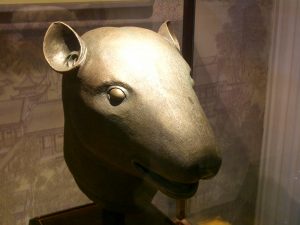
Bronze head of a rat, from the fountain of the Hall of the Calm Seas, European Palaces section of the Garden of Eternal Spring, Beijing, 1750s, bronze (photo: Vmenkov, CC BY-SA 3.0)
A controversial auction
In 2009, two eighteenth-century Chinese bronze sculptures — one representing a rat’s head and the other a rabbit’s — sold at a Christie’s auction in Paris for $40.4 million. Soon afterwards, the art world watched, stunned, as the winning bidder, Cai Mingchao, announced at a press conference in Beijing that he had no intention of actually paying for the sculptures. Cai, a consultant for a group that seeks the return of Chinese artifacts, had intentionally sabotaged the auction as an act of patriotic protest. His bids on these bronze sculptures were intended to prevent the international sale of works of art that Cai and many Chinese citizens consider important artifacts of their cultural heritage.
However, when we examine the history of these sculptures’ creation and the original context in which they were displayed, the issue becomes more complex. No matter where a person stands in the debate, it is important to acknowledge that these works — rather than being purely Chinese — represent an artistic encounter between East and West, marking a moment in Chinese history when the ruling dynasty was extraordinarily active in the collecting, display, and creation of European and European-style art.
The Garden of Eternal Spring
The rat and rabbit heads were originally created for the Garden of Eternal Spring, an enormous Qing Dynasty (1636-1912) garden northwest of the Forbidden City in Beijing, commissioned in the mid-eighteenth century by the Qianlong emperor (Qianlong was the sixth Emperor of the Qing dynasty). It was one of three large imperial gardens — The Garden of Perfect Brightness (Yuanming Yuan), the Garden of Eternal Spring (Changchun Yuan), and the Garden of Elegant Spring (Qichun Yuan). Today, these gardens are collectively referred to as the Yuanming Yuan, despite the fact that they were distinct construction projects.
These gardens are also sometimes called the “Old Summer Palace” in English, which inaccurately implies that this was a place of leisurely summer retreat, secondary in importance to the Forbidden City. In reality, the gardens were the primary residences of the Qing emperors for most of the eighteenth and nineteenth centuries. The Garden of Eternal Spring was begun in 1749 and consisted of hundreds of acres of pavilions, palaces, landscaping, artificial hills, and water features. When one of the few privileged guests who were allowed to view the palaces arrived in the northern section of this vast complex, a surprise awaited. Here, they would suddenly encounter a sequence of stone buildings done in a hybrid Chinese-European style, known as the Xiyang Lou, or “European Palaces.”
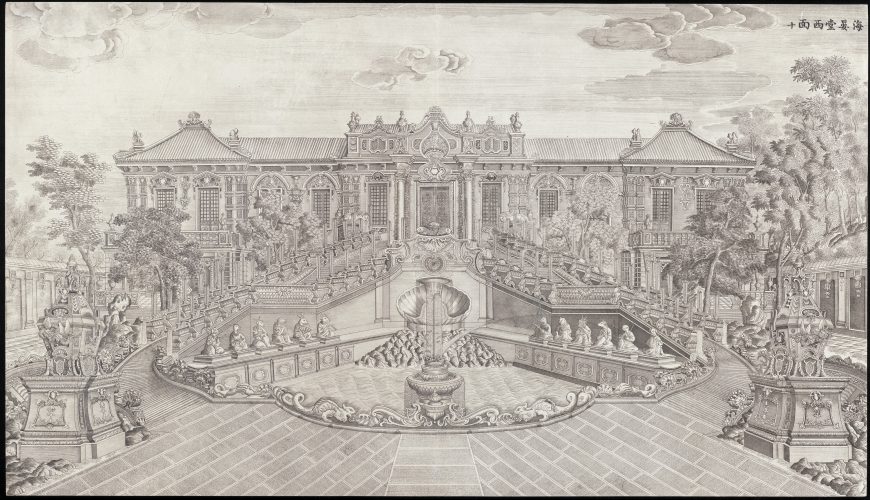
Yi Lantai, West Façade of the Hall of Calm Seas, copperplate engraving, 1781–86 (photo: Getty Digital Collections)
The European Palaces were the result of a collaboration between the Qianlong emperor and a group of European Jesuit missionaries who were working at the Qing court as painters, botanists, mathematicians, and astronomers. The Jesuits are a Roman Catholic religious order founded during the 16th century who had been active as missionaries in China. Christianity had been outlawed during the reign of the Qianlong emperor’s father, however, small number of Jesuits remained in China solely as servants to the emperor and subject to his command.
In the 1740s, one of these Jesuits showed the Qianlong emperor engravings of the fountains at Versailles, the principal royal residence in eighteenth-century France. Fascinated, the Chinese emperor commissioned an Italian Jesuit painter named Giuseppe Castiglione, known as Lang Shining in China, to oversee the construction of a similar fountain. Eventually this project dramatically expanded from a single fountain to an entire complex of palaces, scenic views, and waterworks. Although the European Palaces are usually attributed to Castiglione alone, he actually collaborated on this project with the prolific Lei family of imperial Chinese architects and with other Jesuits at court, including a hydraulics expert and mathematician named Michel Benoist.
A landscape full of surprises
According to traditional Chinese garden design, a garden should include discrete scenes that are sequentially revealed to the visitor as they traverse the landscape. Each view should contain an unexpected element that would astonish the viewer in its creativity and cleverness. The European Palaces, despite their foreign appearance, are fully in line with this tradition. A wall enclosed the section of the garden where the European palaces were; only the tall roofs of the structures, covered in traditional Chinese ceramic tiles, were visible from the rest of the garden. The viewer would have no reason to suspect that the buildings were unusual until they passed through the gate and suddenly encountered this fantastical vision of Europe.
As visitors traveled through the palace complex, it continuously concealed and revealed surprises. For example, the Aviary, which held the emperor’s menagerie of peacocks and exotic birds, appeared to be entirely Chinese in design from the western façade; however, after the visitor exited the Aviary on the eastern side, they would look back over their shoulder to see a curved façade done in an exuberant European Rococo style. It would have appeared to them as if they had entered the building in China and exited in Europe.
Another visual trick was placed at the far eastern end of the European Palaces section. After descending from the Hill of Linear Perspective, the visitor would get on a boat to cross the Square Lake. On the eastern shore of the lake, Castiglione had painted twelve illusionistic scenes using European linear perspective. These paintings were meant to fool the viewer into thinking that an entire European city street had been constructed in the garden.
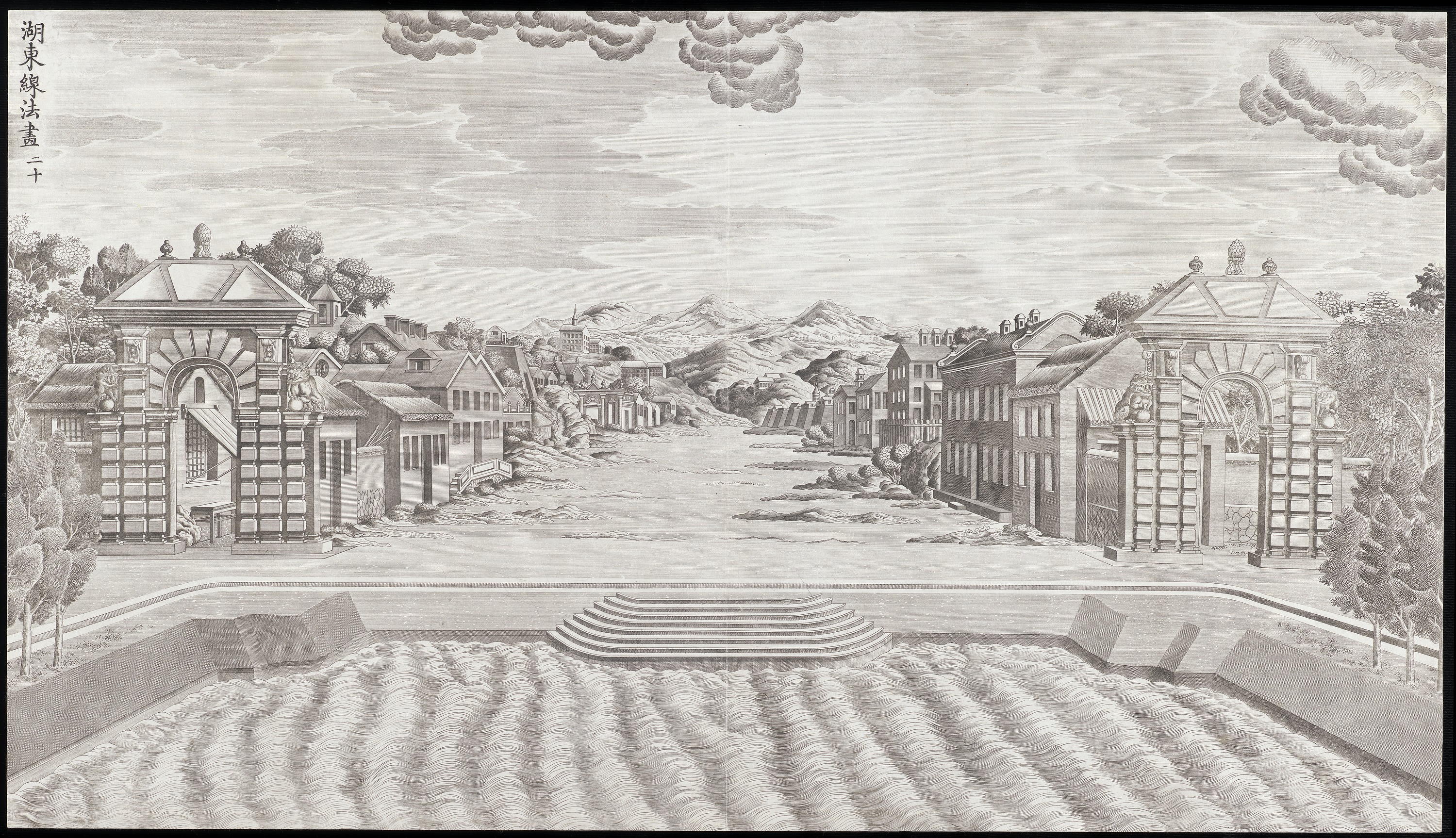
Yi Lantai, Perspective Painting of the Lake to the East, copperplate engraving, 1781–86 (photo: Getty Digital Collections)
Collecting Europe
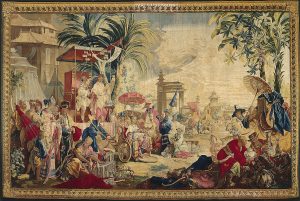
Designed by François Boucher, woven by the Beauvais Manufactory, The Chinese Fair, tapestry, designed 1742, woven 1743–45 (Minneapolis Institute of Art)
The Qianlong emperor never actually lived in any of the European palaces and neither did any of his consorts, as has sometimes been asserted. Instead, the function of the European palaces was to hold his enormous collections of European and European-style objects. Some of these treasures were given to the emperor as diplomatic gifts by European monarchs, while others were imported from the West or even created in China as imitations of European luxury goods.
For example, the emperor ordered the construction of a new palace, the Distant Waters Observatory, specifically to display a set of Beauvais tapestries gifted to the emperor by King Louis XV of France. Interestingly, these tapestries, designed by François Boucher, depicted imaginary scenes of China. This was a unique situation in which a European artist’s vision of Asia was hung in a fantastical European architectural setting commissioned by a Chinese emperor.
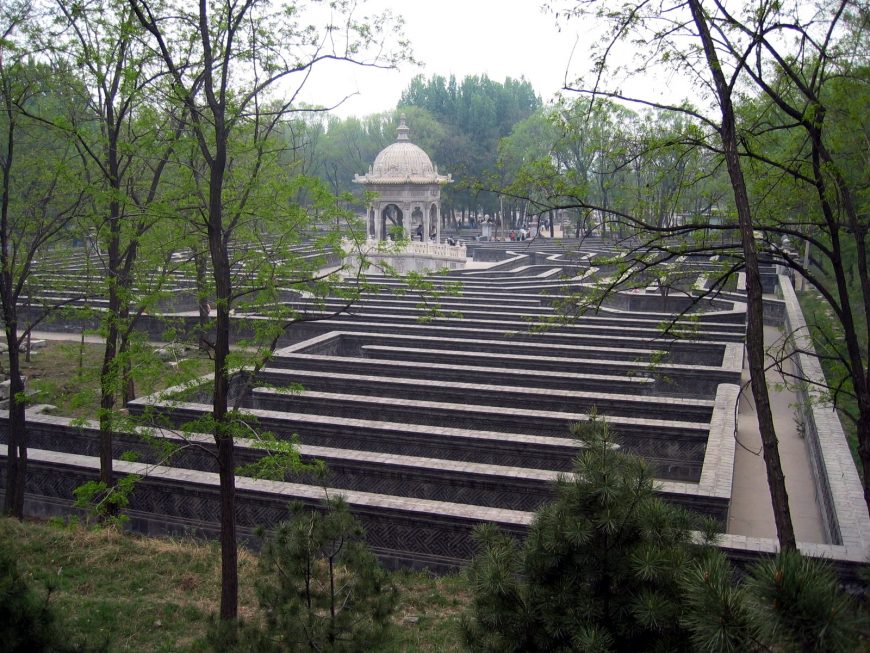
Reconstructed Maze, original was built between 1747 and 1751 and destroyed in 1860. Yuanming Yuan Park, Beijing (photo: Rolf Müller, CC BY-SA 3.0)
The Qianlong emperor also had a particular interest in European technology like clocks and automata. In the garden maze (in Chinese, “The Garden of Ten Thousand Flowers”), the first to be built in China, there was a marble building that housed a collection of bird automata that could sing, as well as a large music box that had been brought from Europe.
The fountains constructed throughout the garden form another collection of European-style machines and are particularly impressive from both an aesthetic and engineering point of view. The fountain in front of the Hall of Calm Seas included an ingenious water clock comprised of sculptures depicting the twelve animals of the Chinese zodiac, including the rat and rabbit sculptures auctioned in 2009. Each animal was associated with a particular two-hour period of the day and water would shoot from the animal’s mouth during the appropriate time. At noon each day, water would spout from all of the animals at once. Even though these fountains were constructed using European hydraulics, their imagery was adapted to suit Chinese taste. For example, nude figures commonly decorated fountains in Europe, but were not used in the Garden of Eternal Spring. Instead, the fountains’ iconography referenced Chinese traditions, such as the animals of the zodiac, as well as other mythological stories and Daoist parables.
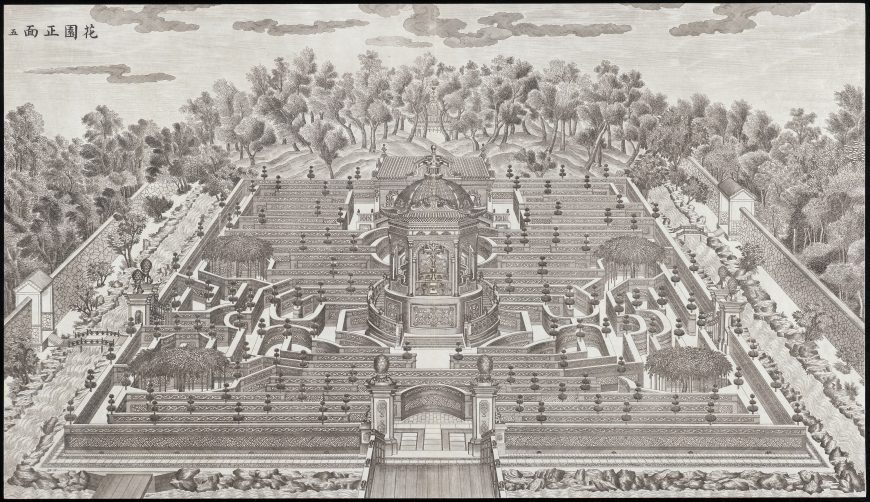
Yi Lantai, Maze (Garden of Ten Thousand Flowers), copperplate engraving, 1781–86 (photo: Getty Digital Collections)
The European Palaces are often interpreted as expressions of the Qianlong emperor’s power. Chinese emperors throughout history have viewed themselves as having a mandate to rule everything “under Heaven” (meaning, the entire world). Several scholars have connected this idea to the European palaces, asserting that the appropriation of European architecture and technology in the Garden of Eternal Spring was meant to be seen as a visual demonstration of Qing superiority over Europe and Qianlong’s dominion over the known world. However, a recent alternative interpretation proposes that the Qianlong emperor was not interested in literally colonizing Europe. Instead, we should view his European Palaces as a means of “collecting” Europe. The emperor and his rare guests were always aware that the built structures in the garden were a fantasy of Europe conjured up at the emperor’s command, demonstrating his mastery over reality itself. [1]
The aftermath
The glory days of the European palaces did not last long. Fortunately, the Qianlong emperor had commissioned Ilantai, a Manchu artist who had trained under Castiglione, to make copperplate engravings of the palaces. Without these engravings, it would be impossible to reconstruct the appearance of the garden, which was looted and badly damaged by British and French troops during the Second Opium War in 1860. In China, the stone ruins of the European palaces now symbolize the late nineteenth- and early twentieth-century history of the country, a time of domination by external imperial powers. Art collectors and government officials often invoke this history when discussing the need to repatriate objects looted from the imperial gardens of Beijing.
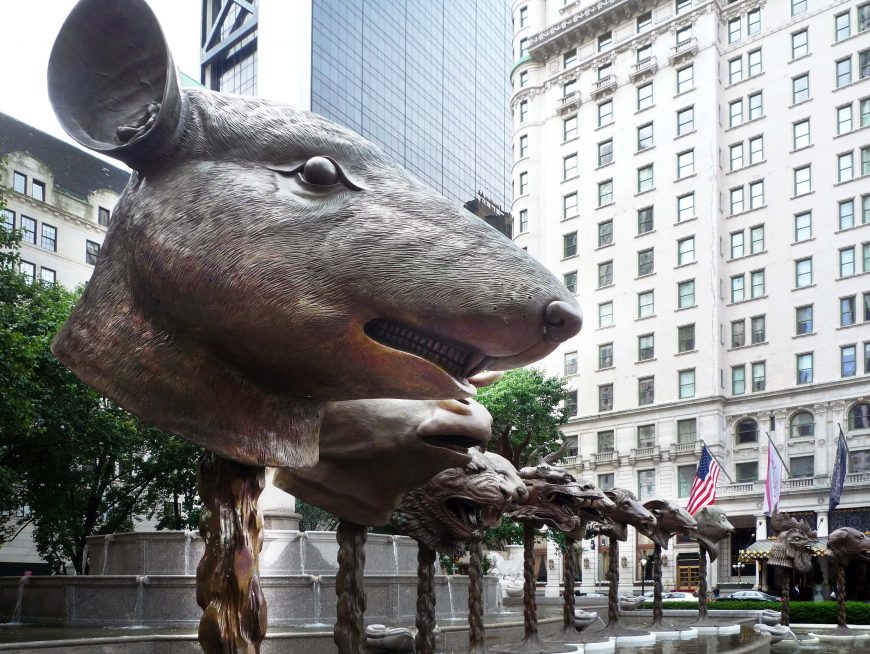
Ai Weiwei, Circle of Animals, Zodiac Heads, 2010, bronze, installation, New York City, May 2-July 15, 2011 (image: Steven Zucker, CC BY-NC-SA 4.0)
Others, however, remember the European palaces as a place of cross-cultural interaction. Ai Weiwei created Circle of Animals/Zodiac Heads in 2010 as a reaction to the 2009 auction of the rat and rabbit head. He reimagined the heads of all twelve zodiac animals from the water clock of the Hall of Calm Seas and has displayed these recreations in public venues all over the world. In interviews, Ai Weiwei has questioned the Chinese narrative about the zodiac heads, recalling the complex multicultural aspects of the Qianlong emperor’s commission:
I don’t think the zodiac heads are a national treasure. They were designed by an Italian, made by a Frenchman for a Qing-dynasty emperor who was the ruler of China, but the Manchus of the Qing dynasty actually invaded China. So, if we talk about national treasure, what nation are we talking about?“Ai Weiwei: Interview Excerpts” in Ai Weiwei, Circle of Animals, Zodiac Heads, ed. S. Delson (New York: AW Asia, 2011), p. 42
Notes
[1] Kristina Kleutghen, Imperial Illusions: Crossing Pictorial Boundaries in the Qing Palaces (Seattle: University of Washington Press, 2015).
Additional Resources
Kristina Kleutghen, Imperial Illusions: Crossing Pictorial Boundaries in the Qing Palaces (Seattle: University of Washington Press, 2015).
The full set of Yi Lantai’s twenty engravings of the European Palaces from Getty Digital Collections
Susan Delson, ed., Ai Weiwei: Circle of Animals (New York: AW Asia, 2011).
Lillian M. Li, “The Garden of Perfect Brightness” on MIT’s Visualizing Cultures – Part 1 (https://visualizingcultures.mit.edu/garden_perfect_brightness/index.html) and Part 2 (https://visualizingcultures.mit.edu/garden_perfect_brightness_02/ymy2_essay01.html)
Marco Musillo, The Shining Inheritance: Italian Painters at the Qing Court, 1699-1812 (Los Angeles: Getty Publications 2016).
Richard E. Strassberg, “War and Peace: Four Intercultural Landscapes” in China on Paper: European and Chinese Works from the Late Sixteenth to the Early Nineteenth Century (Los Angeles: Getty Publications 2011), pp. 89-137.
Greg M. Thomas, “Yuanming Yuan/Versailles: Intercultural Interactions between Chinese and European Palace Cultures,” Art History vol. 32, no. 1 (2009), pp. 115-143.

